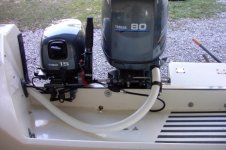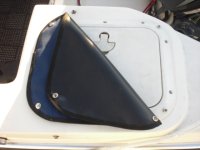Problem is: Between my two big hounds runnin over my engine control cables, the southern sun's UV rays cookin'em and them black cables leavin nice black scuff marks in the well all the time.
For a few dollars I got 4ft of way to heavy duty water jet tubing for a jacuzzi. This stuff is way too tuff. I had to use a sawzall to slit it open. Then it was all I could do to pry it open just enough to slip all inside with two big pry bars and not lose a finger. This stuff is crush proof. If I didn't use the same fuel line for the kicker I'd put it inside too.
To do over, I would recommend the nice blue stuff for swimming pool vacuumes. Much more flexable. If I did the photo right you might see it here. If not it's on page three.
xxxxxxxxxxxxxxxxxxxxxxxx
QUESTION:
How did you get the hose to stay put on the engine and boat side. It seems like when the engine turns side to side, the hose could fall out of the engine. At least that was the problem I had with my previous Yamaha setup using their actual hoses and clamps.
Also, can you please state what the diameter of hose you used and hardware for clamping it in place.
Thanks,



